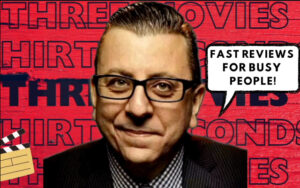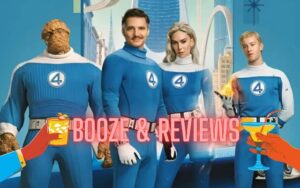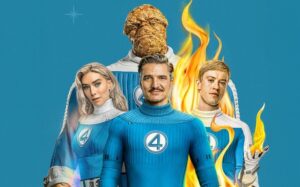CTV NEWS CHANNEL: RICHARD’S SUNDAY MORNING MOVIE REVIEWS FOR AUGUST 24!
 I join CTV NewsChannel anchor Renee Rogers to talk about the thriller “Relay,” the neo-noir “Honey Don’t” and the rock doc “DEVO” on Netflix.
I join CTV NewsChannel anchor Renee Rogers to talk about the thriller “Relay,” the neo-noir “Honey Don’t” and the rock doc “DEVO” on Netflix.
Watch the whole thing HERE!
 I join CTV NewsChannel anchor Renee Rogers to talk about the thriller “Relay,” the neo-noir “Honey Don’t” and the rock doc “DEVO” on Netflix.
I join CTV NewsChannel anchor Renee Rogers to talk about the thriller “Relay,” the neo-noir “Honey Don’t” and the rock doc “DEVO” on Netflix.
Watch the whole thing HERE!
 Fast reviews for busy people! Watch as I review three movies in less time than it takes to make the bed! Have a look as I race against the clock to tell you about the thriller “Relay,” the survival thriller “Eden” and the neo-noir “Honey Don’t.”
Fast reviews for busy people! Watch as I review three movies in less time than it takes to make the bed! Have a look as I race against the clock to tell you about the thriller “Relay,” the survival thriller “Eden” and the neo-noir “Honey Don’t.”
Watch the whole thing HERE!
 SYNOPSIS: Ron Howard’s “Eden” is a star-studded—Ana de Armas, Vanessa Kirby, Sydney Sweeney, Jude Law and Daniel Brühl— story of backstabbing, ego and survival set against the unforgiving landscape of a deserted Galápagos Island. Based on a true story, it’s a heart of darkness tale done on an operatic level.
SYNOPSIS: Ron Howard’s “Eden” is a star-studded—Ana de Armas, Vanessa Kirby, Sydney Sweeney, Jude Law and Daniel Brühl— story of backstabbing, ego and survival set against the unforgiving landscape of a deserted Galápagos Island. Based on a true story, it’s a heart of darkness tale done on an operatic level.
CAST: Jude Law, Ana de Armas, Vanessa Kirby, Sydney Sweeney, Daniel Brühl, Felix Kammerer, Toby Wallace and Richard Roxburgh. Directed by Ron Howard.
REVIEW: Based on a true story, “Eden” is an ambitious psychological thriller from director Ron Howard about a utopia that echoes the savagery and societal collapse of “Lord of the Flies.”
The film begins in the early 1930s with Dr. Friedrich Ritter (Jude Law) and his wife Dora Strauch (Vanessa Kirby) leaving the chaos of post-World War I Germany behind in favor of the solitude of Floreana Island in the Galápagos. Ironically, the misanthropic Ritter spends his days writing a philosophical manifesto about the betterment of humanity.
His dispatches to Europe attract the attention of the open-hearted Heinz and Margaret Wittmer (Daniel Brühl and Sydney Sweeney) who, much to Ritter’s annoyance, arrive with the hope of creating a community on the remote island.
Ritter’s solitude is further interrupted when the flamboyant Baroness Eloise Bosquet de Wagner Wehrhorn (Ana de Armas), and her two lovers land on the island with the idea of opening a luxury hotel on the beach.
A tale of survival, jealousy, betrayal, and violence, “Eden” is about the collapse of idealism. Director Ron Howard and screenwriter Noah Pink explore human nature through a jaundiced lens. The film takes its time escalating the power struggles that eventually erupt into violence, building tension as it does so, but a lack of energy in the film’s first half, as jealousy, deception, and betrayal blossom, makes our introduction to the story a bit of a slog.
Despite Jude Law’s full-frontal nudity and grotesque infected tooth, things liven up considerably when the larger-than-life Baroness and entourage show up. It’s a reset for the staid storytelling of the first half. Not only do her hedonistic ways alienate the island’s occupants, but she actively attempts to pit the Friederichs against the Wittmers. Her actions are the match to the powder keg, leading to the film’s more sordid aspects. The Baroness’s luridly glamorous presence adds some much-needed zip and Ana de Armas steals every scene she appears in with a deadly mix of charm and menace.
There is much to recommend in “Eden.” Gorgeous cinematography by Mathias Herndl and a tense score from Hans Zimmer go a long way to sell the story, but slack storytelling mars what could have been a fascinating trip to Floreana Island and the human condition.
![]() I joined CTV NewsChannel anchor Roger Peterson to have a look at new movies coming to theatres including the friends and family of “The Fantastic Four: First Steps,” the dark rom com “Oh, Hi!” and the documentary “Marlee Matlin: Not Alone Anymore.”
I joined CTV NewsChannel anchor Roger Peterson to have a look at new movies coming to theatres including the friends and family of “The Fantastic Four: First Steps,” the dark rom com “Oh, Hi!” and the documentary “Marlee Matlin: Not Alone Anymore.”
Watch the whole thing HERE!
![]() I joined CTV NewsChannel anchor Roger Peterson to have a look at new movies coming to theatres including the friends and family of “The Fantastic Four: First Steps,” the grip it and rip it sequel “Happy Gilmore 2” and the dark rom com “Oh, Hi!”
I joined CTV NewsChannel anchor Roger Peterson to have a look at new movies coming to theatres including the friends and family of “The Fantastic Four: First Steps,” the grip it and rip it sequel “Happy Gilmore 2” and the dark rom com “Oh, Hi!”
Watch the whole thing HERE!
![]() I sit in on the CFRA Ottawa morning show with host Bill Carroll to talk about the new movies coming to theatres including the friends and family of “The Fantastic Four: First Steps,” the dark rom com “Oh, Hi!” and the documentary “Marlee Matlin: Not Alone Anymore.”
I sit in on the CFRA Ottawa morning show with host Bill Carroll to talk about the new movies coming to theatres including the friends and family of “The Fantastic Four: First Steps,” the dark rom com “Oh, Hi!” and the documentary “Marlee Matlin: Not Alone Anymore.”
Listen to the whole thing HERE!
 I join the Bell Media Radio Network national night time show “Shane Hewitt and the Night Shift” for “Booze & Reviews!” This week I review “The Fantaastic Four: First Steps” and tell you about some fantastic drinks to enjoy while watching the movie.
I join the Bell Media Radio Network national night time show “Shane Hewitt and the Night Shift” for “Booze & Reviews!” This week I review “The Fantaastic Four: First Steps” and tell you about some fantastic drinks to enjoy while watching the movie.
Click HERE to listen to Shane and me talk about the “anti-woke” “Basic Instinct” remake, some everything-old-is-new-again music from Stevie Nicks and Lindsey Buckingham and why rock music os cool again.
For the Booze & Reviews look at “The Fantastic Four: First Steps” and some fantastic cocktails to pair with it, click HERE!
 Fast reviews for busy people! Watch as I review three movies in less time than it takes to make the bed! Have a look as I race against the clock to tell you about the friends and family of “The Fantastic Four: First Steps,” the dark rom com “Oh, Hi!” and the documentary “Marlee Matlin: Not Alone Anymore.”
Fast reviews for busy people! Watch as I review three movies in less time than it takes to make the bed! Have a look as I race against the clock to tell you about the friends and family of “The Fantastic Four: First Steps,” the dark rom com “Oh, Hi!” and the documentary “Marlee Matlin: Not Alone Anymore.”
Watch the whole thing HERE!
 SYNOPSIS: Set on the 1960s-inspired parallel Earth-828, “The Fantastic Four: First Steps,” the new Marvel movie now playing in theatres, sees Reed Richards/Mister Fantastic (Pedro Pascal), Sue Storm/Invisible Woman (Vanessa Kirby), Johnny Storm/Human Torch (Joseph Quinn), and Ben Grimm/The Thing (Ebon Moss-Bachrach) defend Earth from the gargantuan planet-devouring villain Galactus (Ralph Ineson) and his emissary, the cosmic surfboard riding Silver Surfer (Julia Garner).
SYNOPSIS: Set on the 1960s-inspired parallel Earth-828, “The Fantastic Four: First Steps,” the new Marvel movie now playing in theatres, sees Reed Richards/Mister Fantastic (Pedro Pascal), Sue Storm/Invisible Woman (Vanessa Kirby), Johnny Storm/Human Torch (Joseph Quinn), and Ben Grimm/The Thing (Ebon Moss-Bachrach) defend Earth from the gargantuan planet-devouring villain Galactus (Ralph Ineson) and his emissary, the cosmic surfboard riding Silver Surfer (Julia Garner).
CAST: Pedro Pascal, Vanessa Kirby, Ebon Moss-Bachrach, Joseph Quinn, Julia Garner, Natasha Lyonne, Paul Walter Hauser, and Ralph Ineson. Directed by Matt Shakman.
REVIEW: Like a lot of great speculative fiction, “The Fantastic Four: First Steps” isn’t really about the spectacle or the saving the world. Sure, there’s a humungous villain who makes the Statue of Liberty look like a Lego Minifig and the fate of mankind hangs is in the hands of the Four, but that stuff is there simply to act as a delivery system for a story about community, hope and family.
A standalone film—you won’t need to read the MCU wiki page to get up to speed—it dispenses with the origin story in a zippy newsreel that explains how scientists Reed Richards and Sue Storm, Johnny Storm and test pilot and astronaut Ben Grimm gained superpowers after exposure to radiation cosmically altered their DNA during a space mission, transforming them into Mr. Fantastic, Invisible Woman, Human Torch, and The Thing.
With that out of the way, director Matt Shankman gets to the world building.
Set in a retro-chic 1960s-inspired New York City, the film’s look is part “Mad Men,” part “Jetsons,” and reflects the Camelot style optimism of the era.
That it’s a tip of the hat to 1961, the year “The Fantastic Four” debuted, and visually sets the film apart from all other MCU movies, are nice thematic and visual bonuses.
More importantly, director Shakman and screenwriters Josh Friedman, Eric Pearson, Jeff Kaplan, and Ian Springer blend the existential threat of the end of the world (What’s a superhero movie without the threat of the end-of-the-world?) with a surprisingly intimate portrait of The Fantastic Four as a close-knit family.
Sue and Reed are expectant parents, managing the anxiety of having their first child who may, or may not, inherit their altered DNA. Sue’s brother, the hot-headed Johnny, who can burst into flame at will, and family friend Ben, who has permanently morphed into the gentle giant The Thing, are set up to be doting uncles when they aren’t goofing around or saving the world.
None of it would work if the cast didn’t click.
Pascal brings intelligence and emotional depth to Reed while Quinn plays Human Torch as an impulsive but warm-hearted character. The movie’s heart and soul, however, comes from Moss-Bachrach’s motion-capture performance and Kirby’s portrayal of a mother who will sacrifice everything to protect her child.
Even under a digital mountain of CGI, Moss-Bachrach finds pathos in Ben/The Thing’s situation. He’s a genial presence in the family unit, bringing warmth and humour, but it’s the truncated scenes with love interest Rachel Rozman (Natasha Lyonne) that humanizes the craggy, 500-pound character. They’re brief and under-written, but Moss-Bachrach makes the most of them.
Fierce yet vulnerable, compassionate yet steely, Kirby delivers a version of Sue Storm that has depth, as a maternal character and a superhero.
The emphasis on family, community and character are at the very heart of the film. There is spectacle, and the movie ultimately submits to a busy climax, but it’s not an all-out Action-A-Rama. The fireworks come from the characters, not the battle scenes, and while it may be a tad earnest and a bit straightforward for fans looking for loud ‘n proud battle scenes, it succeeds because it takes interesting, thoughtful first steps into a new superhero franchise.